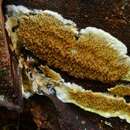fi
nimet breadcrumb-navigoinnissa


Die Hausschwämme (Serpula) sind eine Pilzgattung aus der Familie der Hausschwammverwandten; trotz ihrer flachen, dem Substrat aufliegenden Fruchtkörper gehören sie zur Ordnung der Dickröhrlingsartigen (Boletales).
Die Typusart ist Merulius destruens.[1]
Die Hausschwämme bilden resupinate (dem Substrat anliegende) bis effuso-reflexe (an den Rändern vom Substrat abstehende) fleischige bis wachsartige Fruchtkörper, deren Oberfläche höckerig-faltig, bei manchen Arten auch stoppelig oder unregelmäßig porig ist. Die doppelwandigen Sporen sind kugelig bis ellipsoid, sie sind gelblich bis braun gefärbt.
Die Hausschwämme sind saprobiontische Holzbewohner, die eine intensive Braunfäule im befallenen Holz erzeugen.
Die Gattung enthält weltweit 15 Arten, von denen 2 in Europa vorkommen:[2]
Insbesondere der Echte Hausschwamm ist ein bedeutender und gefürchteter Holzschädling, da er im Gegensatz zu den meisten anderen in Gebäuden vorkommenden Pilzarten (wie dem braunen Kellerschwamm) in der Lage ist, viele Meter weit durch Mauerwerk zu wachsen.
Es ist üblich, alle Holzbauteile im Umkreis von wenigstens einem Meter von sichtbarem Befall zu entfernen, um Mycel zu entfernen, die unsichtbar unter der Oberfläche verlaufen. Befallenes Mauerwerk sollte mit offener Flamme und mit Fungizid behandelt werden.
Neben Holz findet der Pilz auch auf anderen organische Materialien wie u. a. Textilien, Papier, Spanplatten, Stroh und Schilf gute Wachstumsvoraussetzungen.
Die Hausschwämme (Serpula) sind eine Pilzgattung aus der Familie der Hausschwammverwandten; trotz ihrer flachen, dem Substrat aufliegenden Fruchtkörper gehören sie zur Ordnung der Dickröhrlingsartigen (Boletales).
Die Typusart ist Merulius destruens.
Serpula is a genus of fungi in the family Serpulaceae.
The term was originally defined by Christiaan Hendrik Persoon as a section of the genus Merulius in 1801.[2] British botanist Samuel Frederick Gray raised it to genus status in his 1821 work The Natural Arrangement of British Plants.[3] The name is derived from the Latin verb serpěre "to creep".[4] Synonyms include Johann Heinrich Friedrich Link's 1809 Xylophagous, Christian Hendrik Persoon's 1825 Xylomyzon, Narcisse Théophile Patouillard's 1874 Gyrophora, and Patouillard's 1897 Gyrophana.[1]
Serpula forms a clade with at least two other closely related genera, Austropaxillus and Gymnopaxillus, the three composing the family Serpulaceae.[5] It is thought that the common ancestor was saprotrophic, and that ancestor to the latter two genera became mycorrhizal. Using molecular clock analysis, the split between Austropaxillus and Serpula has been estimated to have occurred about 34.9 mya, roughly coinciding with the separation of South America and Australia from Antarctica.[5]
The number of species is uncertain – the two species S. lacrymans and S. himantioides have been considered to be a single species, or the latter species has possibly five cryptic species within its complex.[5]
The members of the genus Serpula form flat brown fruit bodies that cover the surface they are growing on (known as the substrate). The hymenophore, or spore-forming surface, generally has a wrinkled appearance.[5]
The species grow on, and digest, mainly coniferous wood, causing a process known as brown rot. One species, dry rot (S. lacrymans), is a highly destructive agent of houses.[5] Damp structural timber is an ideal substrate for the germination of Serpula spores. The fungal hyphae penetrate the wood and release enzymes that break down structural polysaccharides such as cellulose. There may be no external indications that the fungus is present until the rot is far advanced and fruit bodies are formed. The strand mycelium of Serpula, which can be up to 8 mm thick, are invasive and can spread over non-nutritive surfaces[6] to find new food sources, even spreading through pores in stone, brickwork, and cement. After its initial growth period, the fungus can produce the water it needs and can continue growth into dry timber, eventually degrading it to powder—hence the term "dry rot". S. lacrymans is the most serious cause of building timber decay in the UK and northern Europe.[7]
The Dictionary of the Fungi (10th edition, 2008), suggests that the genus contains two species.[8] As of December 2014, the nomenclatural database Index Fungorum indicates 11 species:[9]
Serpula is a genus of fungi in the family Serpulaceae.
Vamm (Serpula) on puravikulaadsete selts mädikuliste sugukonda kuuluv perekond seeni.
Perekonnas on kaks liiki, majavamm ja metsvamm, mida mõlemat leidub ka Eestis.
Vamm (Serpula) on puravikulaadsete selts mädikuliste sugukonda kuuluv perekond seeni.
Perekonnas on kaks liiki, majavamm ja metsvamm, mida mõlemat leidub ka Eestis.
Serpula est un genre de champignons de la famille des Serpulaceae.
Ces champignons sont résupinés et saprophytes.[réf. nécessaire]
Selon Index Fungorum (11 avril 2014)[1] :
Serpula est un genre de champignons de la famille des Serpulaceae.
Serpula[1] è un genere di funghi basidiomiceti appartenente all'ordine Boletales.
La specie tipo è Serpula destruens (Pers.) Gray (1821).
Serpula è un genere di funghi basidiomiceti appartenente all'ordine Boletales.
Trobagrybis (lot. Serpula) – grybų gentis, priklausanti baravykiečių (Boletales) eilei.
Vaisiakūniai padriki, mėsingi arba plėvelės pavidalo, stori, pradžioje balti, vėliau tampa rudais. Tai parazitinis grybas, augantis ant išvirtusių, nukirstų spygliuočių medžių taip pat drėgnuose mediniuose pastatuose (ant grindų, palangių, sienų). Medieną ardo labai greitai[1].
Lietuvoje auga 3 rūšys:
Trobagrybis (lot. Serpula) – grybų gentis, priklausanti baravykiečių (Boletales) eilei.
Vaisiakūniai padriki, mėsingi arba plėvelės pavidalo, stori, pradžioje balti, vėliau tampa rudais. Tai parazitinis grybas, augantis ant išvirtusių, nukirstų spygliuočių medžių taip pat drėgnuose mediniuose pastatuose (ant grindų, palangių, sienų). Medieną ardo labai greitai.
Lietuvoje auga 3 rūšys:
Žalingasis trobagrybis (Serpula lacrymans) Plėvelinis trobagrybis (Serpula himantioides) Pušinis trobagrybis (Serpula pinastri)Serpula is een geslacht van schimmels
Deze lijst is mogelijk niet compleet.
Serpula is een geslacht van schimmels
Serpula (Pers.) Gray (stroczek) – rodzaj grzybów z rodziny stroczkowatych (Serpulaceae)[1]. W Polsce występują 2 gatunki[2].
Pozycja w klasyfikacji według Index Fungorum: Serpulaceae, Boletales, Agaricomycetidae, Agaricomycetes, Agaricomycotina, Basidiomycota, Fungi[1].
Polską nazwę nadał Władysław Wojewoda w 2003 r. W polskim piśmiennictwie mykologicznym należące do tego rodzaju gatunki opisywane były także jako drzewoniszcz[2]. Synonimy nazwy naukowej: Gyrophana Pat., Gyrophora Pat., Merulius sect. Serpula Pers., Xylomyzon Pers., Xylophagus Link[3].
Nazwy naukowe na podstawie Index Fungorum[5]. Nazwy polskie według Władysława Wojewody[2].
Serpula (Pers.) Gray (stroczek) – rodzaj grzybów z rodziny stroczkowatych (Serpulaceae). W Polsce występują 2 gatunki.